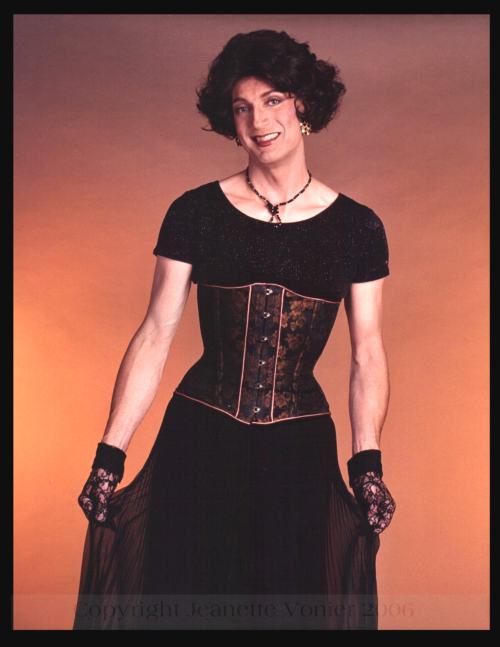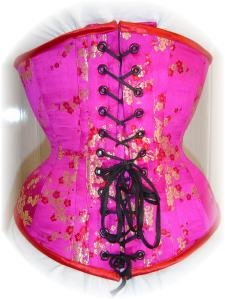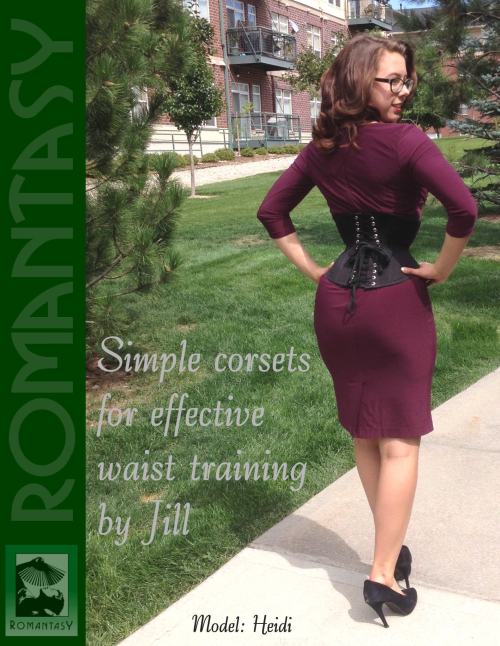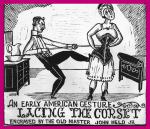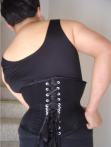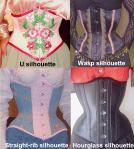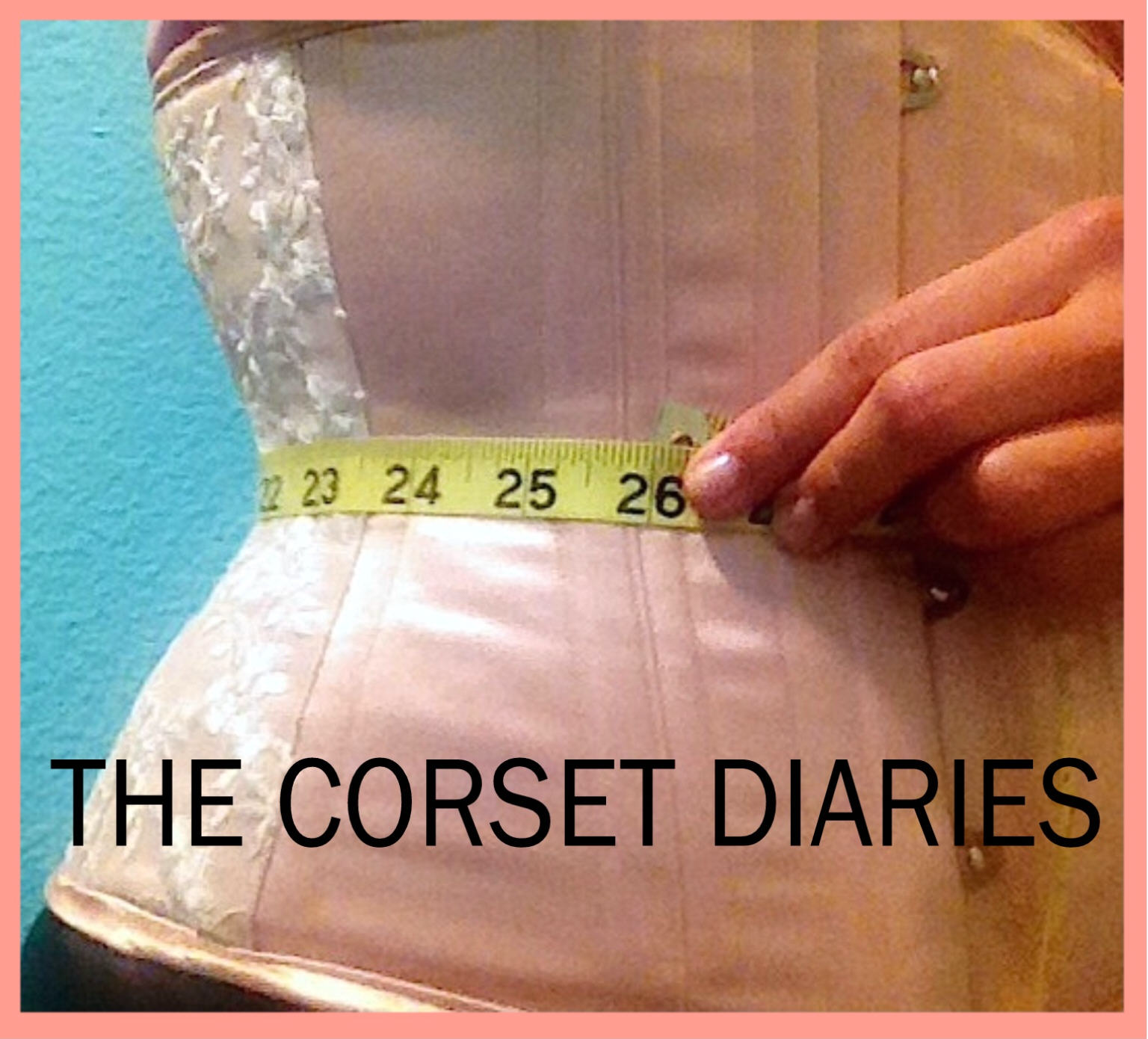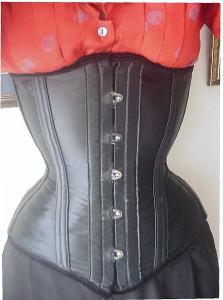 I am pleased to present below in full, the above well-stated position paper authored by a former client and corset enthusiast friend. During my active career purveying custom corsetry from 1990 to this year, I have had one client convince his insurer (Blue Cross), based upon a doctor’s prescription for a “back brace” for a back ailment, to cover $150 cost for a new corset for each of two years. It is conceivable that a few other enlightened insurers and doctors might make this happen more often if only the corset wearer would make the case. Perhaps the below article will be sufficient to convince your doctor to take a leap of faith; after all they rather easily proscribe drugs and even ugly, thick, rigid medical back braces that are far inferior to comfortable, well fit and lighter-weight custom corsets. Congratulations to Lisa for this scholarly, well-argued case for the corset as valid compression therapy. Enjoy!
I am pleased to present below in full, the above well-stated position paper authored by a former client and corset enthusiast friend. During my active career purveying custom corsetry from 1990 to this year, I have had one client convince his insurer (Blue Cross), based upon a doctor’s prescription for a “back brace” for a back ailment, to cover $150 cost for a new corset for each of two years. It is conceivable that a few other enlightened insurers and doctors might make this happen more often if only the corset wearer would make the case. Perhaps the below article will be sufficient to convince your doctor to take a leap of faith; after all they rather easily proscribe drugs and even ugly, thick, rigid medical back braces that are far inferior to comfortable, well fit and lighter-weight custom corsets. Congratulations to Lisa for this scholarly, well-argued case for the corset as valid compression therapy. Enjoy!
A Case for the Corset: 21st Century Applications (c) Lisa Parkhill 2019
Autists Temple Grandin and Tom McKean are noted for pioneering the creation of deep pressure devices which enveloped their bodies in manners that promoted a feeling of security, after spending their lives seeking comfort through the use of various household items and techniques such as “embracing sofa cushions and wrapping [up]…tightly in blankets” (Almanza, 2016, p. 167). Prior to the invention of a “series of therapeutic technologies including: squeeze chairs, weighted vests, blankets, and stuffed animals that provide deep controlled pressure” (Almanza, 2016, pp.167-168), there already had been such a compression device commonly in use and available for centuries, in the form of the corset. In the late 19th and early 20th centuries, however, the feminist movement viewed the corset as a symbol of oppression, demanded freedom from it and eventually, society acquiesced.
Throughout much of recorded time, European children were put into stiffened bodices at the age of five or six (Grogan, 2019, pp. 39-40), wearing corsets throughout their entire lifetimes. It is a distinct possibility that autism and various other mental health issues such as anxiety were not specifically noted by medical specialists,because they were likely kept in check to some degree by the practice of corseting early in one’s lifetime–most females and even some males had been swaddled by the comforting sensation of pressure on their bodies for as long as they could remember. By the 21st century,the practice of wearing corsets had been relegated to the past, yet it is strangely coincidental that there are increasingly diverse emotional health and physical support issues noted by the medical community in general which have moved many emotional health issues, as well as physical support concerns, to the forefront of modern discussions regarding practical therapeutic solutions for patient care.
In these times of open discourse about mental health issues affecting people of all ages, modern corsets should be validated and promoted by the medical community as viable compression therapy. Patients suffering from depression, generalized anxiety disorder, panic attacks, PTSD and body dysmorphia can all strongly benefit from the feelings of soothing calm, safety and security a corset can provide.MyMed.com states that “compression therapy is already considered an effective means of treatment for autism” and “that the feeling of being embraced through wearing a corset can be seen as a means of comfort” (Poole, p.20), reaffirming the need for physicians’ serious consideration of custom corsets as integral parts of more medical treatments in the United States, which should be covered by insurance companies. If compression therapy has been long touted in an emotional support garment for anxious pets and humans alike as the “Thunder Shirt”, (Thunderworks Insanely Calm, 2019), it stands to reason that the medical community should recognize the custom corset as a viable prosthetic device for the treatment of patients with complex emotional disorders. Medical professionals know that the benefits of fitted prosthetics far outweigh a standard issue one, but in order to derive all the benefits of a standard issue prosthetic brace it must be worn in the manner prescribed by the physician. Naturally, an aesthetically pleasing comfortable device is far more likely to be used by a patient than a bulky and unattractive one, hence prescribing custom corsets is logical and viable.
The Benefits of Compression Therapy
In Calming Effects of Deep Touch Pressure in Patients with Autistic Disorder, College Students, and Animals, Dr. Temple Grandin discusses the “deep touch pressure device” she invented at 18 dubbed “the squeeze machine”,which helped her overcome her own hyper-sensory issues and “allays her nervousness” (Grandin, 1992, p.1). The custom corset is a portable source of deep pressure therapy and since the corset’s laces are self-manipulated, it empowers the patient as an active participant in their own therapy. Grandin’s article declares that “deep pressure touch has been found to have beneficial effects in a variety of clinical settings” (Grandin, 1992, p.1). This study is 27 years old, yet the concept of applying compression as therapeutic patient care is still in its infancy, with significant untapped potential on the horizon.
Grandin’s article reports the data collected from testing the effectiveness of her deep pressure therapy on college age individuals, referred to as “normal adults”who had no diagnosis of autism, ADHD, Asperger’s syndrome or any disorder whatsoever. “[The] college students were found to be relaxed after the use of the squeeze machine”,and it was also observed that “relaxation was physically evident in some subjects” (Grandin, 1992, p.3-4). As well as noting the calming influence of compression, the article also reports that medications have, in fact, been reduced in certain patients who have had their treatment plans augmented with deep pressure therapy (Grandin, 1992, p.7), so it is not unreasonable to think it possible to arrive at treatment solutions that aren’t centered in pharmacology for patients whose lives are compromised by debilitating emotional distress,with the aid of compression therapy.
Biased Opinions
Unfortunately, the history of corseting is fraught with stigma, biased perspectives and stereotypical opinions.Retired corsetiere Brooke Nelson, proprietress of Dragontown Corsets,asserts that “it may be likely that the holdover of Victorian ideas about corsetry are alive and well concerning [the corset’s] potential health risks” (Nelson, 2019), which seems to have had a large bearing on societal stigma associated with the garment. In the 1800s, fashions were dictated by the shapes the wearers were molded into by corseting from an early age and not anatomically or physiologically conscious of the wearers’ bodies. The trepidation of corsets would dissipate if it were more widely known that an aspiring theatrical designer once paid rapt attention to the fact that the Victorian standard of corset no longer applies.
Patterned for the Modern Body
The antique patterns were redesignedfor modern body proportions in the 1950s by Roland Loomis,also known as The Ol’ Corsetiere or Fakir Musafar (Grogan, 2019, p. 49). As he attempted to reproduce an 1880s ball gown in costuming college, he discovered that a corset was prerequisite for the proper look of the costume but there were none to be found. In his research, he found that the proportions of women’s bodies had changed much over the years in comparison to the Victorian patterns he found, so using data from some 200 women that had been in theatre shows, he made forms on which to plan his updated patterns based on the “figure dimensions for some 200 women” whose measurements“fell into one of five basic [figure] groups”. Finally, Loomis “had made the first new patterns for modern bodies in 75 years, and they worked!” (Vale, Juno, 1989, p.31). Hi sdesign theory coupled with his attention to physiological and anatomical detail,is considered by many to be the advent of modern corset design. He later spent a year mentoring Ruth Johnson[BR Creations] how to craft them from his “original patterns, which took several years to refine” (Vale, Juno, 1989, p.32).
Pharmaceutical Irony
Although there has been much relevant research done on the benefits that compression therapy can offer a person’s body and psyche, the corset has been quite over looked as assistance topromote a patient’s physical and mental health,while pharmacological solutions continue to thrive. Many incidences of drug dependency began with drugs prescribed to aid the sufferers of physical pain or emotional trauma. It is very ironic that the well-informed patient is constantly encouraged in the media to consult with their doctors regarding whether they think a certain advertised drug may be appropriate for them. With the highly publicized national issue of the opioid crisis and drug addiction in the United States, to overlook the obvious aid a customcorset can provide seems preposterous, especially when compression therapy has been clinically proven as an effective coping strategy for emotional distress.
The Need for Education
With many online influencers taking photos of themselves in “off the rack” waist cinchers and posting them on social media, many parents are concerned that competitiveness focused on having small waists will harm their children. The article “Total Waist” (Teen Vogue,
2016) focuses on“the potential hazards” of waist training claims, saying that “when you wear this uncomfortable contraption all day, it is a constant reminder that there’s something wrong with your body”. The article further elaborates that “the thought is dangerous and destructive for [those] who already have higher chances for eating disorders” (Ciencin Henriquez, 2016). If young people are that easily influenced by people wearing waist cinchers, they likely are already in a place of body dysmorphia. The waist cincher is merely a symbol of instant gratification,therefore it would be extremely favorable for them to see positive change “right now”, as many are conditioned to do in the immediacy of today’s internet culture. It is quite possible for young people and adults to work together safely toward better body ideals in the long run with educational guidance and the help of a custom corset or cincher.
A Treasure Trove of Information
Ann Grogan’s Corset Magic, first published in 2003, is filled with practical advice for people who are curious about corsets, also those people who are interested in waist training.
After sustaining a serious back injury,Grogan started wearing corsets as support and that journey in part inspired her to open Romantasy Exquisite Corsetry in 1990. As a civil trial lawyer in California who practiced law for 16 years, she didn’t want to risk her reputation giving dangerous advice so she asked medical professionals to review Corset Magic, which she calls“the culmination of what I have learned during many years of personal and professional experience as a corset wearer, designer, purveyor, writer, and researcher”, stating that the book is “intended as a reference volume only, not [a] medical manual”, also that “the information [in the book is] designed to help you make informed decisions about your lifestyle [and] your sense of well-being” (Grogan, 2016, p. 4). The reviews were all positive and encouraging.
The book discusses everything about corsets from what is called “seasoning” the corset prior to wearing it (easing it into use and forming the fabric to your body), to types of exercise that strengthen the body while corseted, and how to choose the best coverage that suits one’s body type best. While the data collected through her research and published in Corset Magic may not be considered academic per se,the advice Grogan metes out is easily understood. Documented in itis the progression of men and women who have improved posture,greater self-esteem and all-around better health as they learned better nutrition and exercise habits while wearing custom corsets.
The Many Benefits of Corseting
Lucy Williams, author of Solaced: 101 Uplifting Narratives About Corsets, Well-Being, and Hope(2016),agrees with Grogan’s methodology, endorsing Corset Magic on her website as“the waist training bible”for those serious about wearing corsets and waist training. Williams’ interest in corsets began with her interest in historical cosplay, but after coping with chronic back pain and posture issues, her interest deepened. Realizing that the secure feeling of wearing a corset helped her cope with the anxiety of being far from home, Williams was inspired to ask others about how they felt about corsets, since what she felt while wearing a corset was solace, saying that “the corset’s stability has helped [many] feel more in control and less vulnerable to the stresses of daily life” (Williams, 2019).The number of responses were overwhelming, so she selected a representative cross section of them to include in her book, and an overview of the many mental, emotional and physical benefits that have been reported to her by people who wear corsets for therapy is listed on Williams’ website.
Conclusion
The positive aspects people are experiencing who wear corsets range from back pain relief, stabilized spinal curvature, and relaxed muscle tension in individuals suffering fibromyalgia, to eating disorder control, subdued anxieties, and reduced body dysphoria in trans and gender fluid individuals, and these are all areas in which the medical community expresses concern for their patients’ welfare. Reason dictates that custom corsets provide valuable therapy, and therefore medical specialists must seriously consider the augmentation of them into patients’ treatment plans for new and groundbreaking applications for the health and welfare of their patients.
Although much of the current research done with corseting has been limited to anecdotal and documented group evidence, an educated and well-informed opinion can only be achieved by assimilating all available research, and it is impractical to rely on obsolete and unenlightened information alone. The time has come for the medical community to combine the application of compression therapy and all its benefits by rediscovering the comfort and practicality of the custom corset, thereby propelling the application of the garment out of the age of Victoriana, and into the 21st century.
###
References
Almanza, M. (2016, Summer). Temple Grandin’s squeezemachine as prosthesis. Journal
of modern literature, 39(4), 162-175.
Ciencin Henriquez, J. (2016, April). Total waist. Teen Vogue, 16(3), 94-95.
Grandin, T. (1992). Calming effects of deep touch pressure in patients with autistic disorder,
college students, and animals. Journal of Child and Adolescent Psychopharmacology,
2(1), 1-11.
Grogan, A. (2016, January). Corset magic. Romantasy Exquisite Corsetry. Retrieved November 5, 2019 from http://romantasyweb.com/Merchant2/merchant.mv?Screen=
PROD&Product_Code=book 01&Category_Code=moc
Nelson, B. (2019) email interview, November 30, 2019.
Poole, J. (2019). The dangers and benefits of aesthetic waist training. My Med. Retrieved November 4, 2019 from https://www.mymed.com/health-wellness/body- modifications/the-practice-of-waist-training-and-corsetry/the-dangers-and-benefits-of- aesthetic-waist-training
Thunderworks Insanely Calm (2019). The better calming solution. Thunderworks. Retrieved November 5, 2019 from https://www.thundershirt.com/?msclkid=e8d8d6c665ab13296d8c8b1f53752629&utm_so urce=bing&utm_medium=cpc&utm_campaign=(ROI)%20BR%20- %20ThunderShirt%20%5BExact%5D&utm_term=thunder%20shirt&utm_content=Thun derShirt%20Exact
Vale, V. & Juno A. (1989). Modern primitives, an investigation of contemporary adornment and
ritual. London, UK: Re/Search Publications.
Williams, L. (2016). Solaced: 101 uplifting narratives about corsets, well-being and hope.
Amazon Media EU S.àr.l.edia, E.U: Middlow Publishing.
Williams, L. (2016). Solaced: 101 uplifting narratives about corsets, well-being and hope.
Lucy’s Corsetry. Retrieved November 5, 2019 from https://lucycorsetry.com/corset- benefits-the-book/







